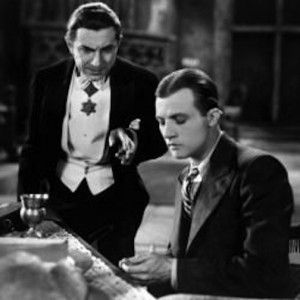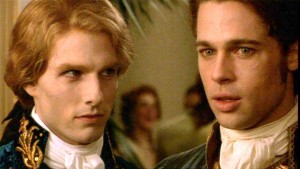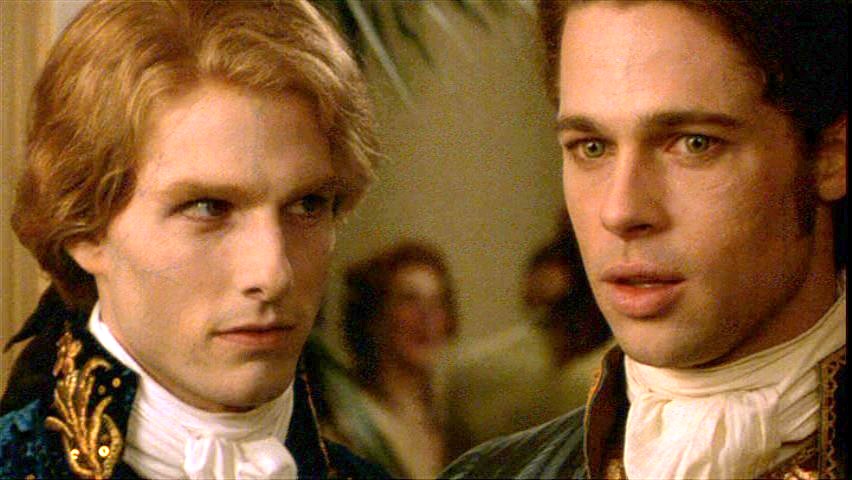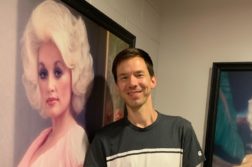VAMPIRES HAVE BEEN a part of popular culture in the West for several centuries. American vampire stories are rooted in the folklore of Eastern Europe, but similar creatures have also turned up in Western Europe, India, and China. The contemporary vampire story has roots in traditional folklore, in 17th- and 18th-century pseudo-science, and in historical figures such as the “Blood Countess,” Elizabeth Bathory, and Romanian ruler Vlad “The Impaler” Tepes. Well-known precursors to today’s stories include the 1748 German poem, “Der Vampyre” and an 1819 short story by John Polidori titled “The Vampyre.” In this story, the vampire, Lord Ruthven, was first portrayed as the “aristocratic seducer” that is so familiar to Americans. Polidori was Lord Byron’s physician, and many readers saw a resemblance between Byron and the vampire.
By the 1840s, vampires were seen in English theatrical productions, and “Varney the Vampire,” created by James Malcolm Rymer, was a popular newspaper serial. In 1871, a vampire story with subtle lesbian undertones, “Carmilla,” by Sheridan Le Fanu was published. In 1897, the best known vampire book, Bram Stoker’s Dracula, was published. Hugely popular in the U.S., it had been adapted for both stage and screen by the 1920s. The first vampire films were actually made by the French in the 1890s. By the 1920s, the Germans had produced Nosferatu, and in 1931 Hollywood jumped in with Tod Browning’s Dracula.
Was Dracula Gay?
Sexuality and homosexuality have been a part of vampire stories in popular culture, mostly as a subtle undercurrent, since at least the 19th century. In the Romantic and Victorian Eras, vampires often served as sexual metaphors. In 1895, Oscar Wilde was being sent to prison for “gross indecency” while Bram Stoker was writing his novel. The lesson must have been obvious, but there are several homoerotic scenes in Dracula. In a time of extreme repression and fear for gay people, using their vampire characters as a metaphor for their own hidden sexuality was an outlet for self-expression. As times changed, these vampires and vampire stories, movies, and later television evolved as well. Vampires, especially in modern American literature, film, and television, can be used as a “window” on gay culture of the corresponding era.

(as Jonathan Harker) in 1931’s Dracula
Bram Stoker was a closeted homosexual and a friend of Oscar Wilde, a not-so-closeted gay man. Stoker idolized Walt Whitman and met him while touring the U.S., and he had a “passionate” relationship with actor Henry Irving. He began writing Dracula one month after Wilde was convicted of sodomy and sentenced to hard labor. In a nod to Wilde, he used the “idiom of Oscar Wilde’s letters to Lord Alfred Douglas” in Dracula. His friend of over twenty years was going to prison, and he began writing a novel about sexual repression and fear. Talia Schaffer (1994) writes that “Dracula explores Stoker’s fear and anxiety as a closeted homosexual man during Oscar Wilde’s trial. … This peculiar tonality of horror derives from Stoker’s emotions at this unique moment in gay history.”
In 1931’s Dracula, the character of Jonathan Harker stands in for the author and his own fears and desires vis-à-vis his repressed homosexual feelings. Harker describes his sensations when about to engage with a trio of female vampires: “I could feel the soft, shivering touch of the lips on the super-sensitive skin of my throat, and the hard dents of two sharp teeth, just touching and pausing there. I closed my eyes in a languorous ecstasy and waited—waited with beating heart.” The use of females in scenes such as this is explained by Christopher Craft (1988). He sees all gay men of this time as wearing a “heterosexual mask” and any erotic male contact as being “mediated” by females, the “correct” gender. Stoker does not let this seeming heterosexual encounter reach fruition; Count Dracula breaks it up, declaring: “How dare you touch him, any of you? … This man belongs to me!”
In a short story from 1911, For the Blood is the Life, American writer F. Marion Crawford demonstrated the same mixture of desire and fear, describing his vampire thus: “She had very red lips and very black eyes, she was built like a greyhound, and had the tongue of the devil.” There is sexual attraction but complete dread at the same time, an apt description of the feelings surrounding same-sex eroticism at this time.
The Era of Repression—for Gays and for Dracula
The inter-war period was a more hopeful time for gays and lesbians, especially in large cities, and this is reflected in the popular culture. The first openly gay films, Different from Others (1919) and Mädchen in Uniform (1931), were produced in Weimar Germany, but urban areas in the U.S. such as Greenwich Village were becoming known as “bohemian enclaves” where homosexual relationships were at least tolerated. There were numerous gay baths bringing sex into a much more public sphere. Harlem, while not as open as the Village, was another oasis of expression in the 1920s and came to be known for “drag balls” that attracted thousands. While these “oases” thrived, the majority of the nation remained conservative in all matters sexual, especially homosexual, and by the late 1930s the social climate was changing even in places such as these.
Vampires were also becoming more conspicuous in American popular culture in the ’20s and ’30s. Just as homosexuals seemed centered in specific areas, vampires were mostly limited to Hollywood films, and both groups were seen as “spectacles” by much of the public (Dracula on the big screen or a Harlem drag ball). Much of gay culture during this time was as flamboyant as was 1931’s Dracula, with his flowing cape, transfixing gaze, and heavy accent. Tod Browning, the director of Dracula, was himself gay, and much of his work centered on the position of the outsider. After his most famous film, he went on to direct Freaks (1932), about a group of outsiders who form their own “family,” and Mark of the Vampire (1935), featuring Bela Lugosi as the vampire. Psychiatry was becoming more prevalent in this era, and in Dracula’s Daughter (1936), vampire Countess Marya Zaleska goes to psychologist Dr. Garth for help. She’s hoping to use psychiatry to free herself of her “vampire curse”—something that unhappy homosexuals might have done.
World War II was in some ways a liberating event for many gay men and lesbians, and so it was for the culture of vampires as well. Gays who had lived their lives on farms or in small towns joined the military, met other gay people, and spent time in large, anonymous cities. Vampire movies stretched in new and interesting ways as well. In Return of the Vampire (1943), a werewolf plays a starring role—a man who becomes something totally wild and unexpected during the full moon. In Creature of the Devil (1943), a vampire is jealous of his twin’s attraction to a woman and uses a “hunchback” (another outsider) to kill him. The mood lightens up in the next wave of films. House of Frankenstein, which featured an “all-star cast of villains,” was released in 1944, and by 1948 movies such as Abbott and Costello Meet Frankenstein (which featured Dracula) were popular.
In the 1944 short story, The Bat Is My Brother, author Robert Bloch, best known as the writer of Psycho (1959), describes a man’s first-person experience of “coming out” as a vampire. He has a “guardian” who helpfully explains: “Yes, I am a vampire. And … so are you!” The guardian shows the new vampire the ropes—an older, more experienced man (or vampire) teaching the cultural norms to a younger one. This new world could seem frightening or overwhelming, and with the counsel of a mentor it becomes as normal as breathing. This vampire story could as easily be describing a young person fresh off the farm in the big city of San Francisco and experiencing gay culture for the first time.
The pre-Stonewall era for gays and lesbians in American society, lasting from the end of World War II to the late 1960s, was mostly a time of repression, fear, and the closet. It was a time of conformity not just for gay people, but for women and other minorities as well, who were expected to play their role in order to keep America safe from “Godless Communism.” In her book Homeward Bound, historian Elaine Tyler May (1999) argues for a similarity between “domestic containment” and Cold War containment policies. She points out that homosexuals had it especially tough and that many “used marriage as a cover during these years to escape stigma and persecution.” Senator Joseph McCarthy, his notorious (and closeted) righthand man Roy Cohn, and others of their ilk were hunting not just communists but homosexuals as well. There were congressional hearings aimed at rooting “sexual perverts” out of government jobs, and postal surveillance of magazines geared toward gay men continued until 1966.
Representations of homosexuality in popular culture were correspondingly negative. In Suddenly, Last Summer (1959), the homosexual character never appears or speaks, and dies a terrible off-screen death, torn to pieces by an angry mob. The movie was based on a play by gay writer Tennessee Williams, whose works A Streetcar Named Desire and Cat on a Hot Tin Roof referenced homosexuality (though not in their movie versions). In 1961’s The Children’s Hour, actress Shirley MacLaine played a repressed lesbian who’s miserable and eventually commits suicide. Gay characters were beginning to appear on screen and stage, but it was necessary that they be desperate souls, and preferably that they die.
Once again, vampires (mostly in film) served as metaphors for the place that gays and lesbians held in American culture at the time. Vampires were evil, scary monsters that children and nice people needed to avoid, just like homosexuals. Many science fiction films of the 1950s, such as Invasion of the Body Snatchers, were metaphors for the hysteria over the communist menace, but could just as easily be metaphors for the “lavender menace” with which many in government were obsessed. In 1951’s The Thing (from Another World), a vampire from outer space runs wild, attacking and killing men and draining them of their blood. This is emblematic of a homophobic society in which male-male contact leads to death or ruin. In Not of this Earth (1957), the creature looks like everyone else but hides a terrible secret: he stalks men. Finally, in Queen of Blood (1966), a female vampire attacks astronauts on a distant planet while trying to breed a new race, somewhat reminiscent of the outlandish belief that gays must go out and “recruit” to replenish their numbers.
Arguably the scariest vampires of this era were those created by Hammer Films. Produced in Great Britain, the films were extravagant by Hollywood standards and popular in the U.S. The first was a 1958 update of Dracula called The Horror of Dracula, starring Christopher Lee (as Dracula) and Peter Cushing (as Dr. Van Helsing). The movie stays relatively close to the novel, as when Dracula chases away the female vampire from Jonathan Harker so that he can maintain control over the young man. This film is much more graphic than the original in depicting both violence and sexuality. Unlike the flamboyant vampire of 1931, the Dracula portrayed by actor Lee is violent, vicious, and authentically frightening. Another difference is that now the vampire is destroyed by exposure to the sun rather than killed with a stake. This is reminiscent of McCarthyism and the quest to force dissidents—along with homosexuals—out into the obliterating light of public exposure.
This need to destroy the enemy is evident in other Hammer films, such as The Brides of Dracula (1960), in which the vampire in torn to pieces and the remains are scattered under the shadow created by a cross. But Dracula tends to rise from the dead, as he does in Dracula, Prince of Darkness (1966). Here he returns by drinking the blood of another man—read into that what you will—but is of course destroyed by the end of the film, this time drowned under a layer of ice. He returns yet again in 1968’s Dracula Has Risen from the Grave, and is again revived by the blood of a man.
The Era of Liberation
Explicitly “gay” movies began to appear following the Stonewall Riots of 1969, starting with The Boys in the Band in 1970 and continuing with such films as Fortune and Men’s Eyes (1971), Dog Day Afternoon (1975), and Midnight Express (1978). There were also a number of “underground” gay movies, notably those of John Waters (1973’s Pink Flamingos and 1975’s Female Trouble), and of course The Rocky Horror Picture Show (1975).
Vampires in American popular culture reflected this opening of the gay closet, yielding a kind of “coming out of the coffin.” In Dracula A.D. 1972, Dracula shows up in the late 20th century and encounters outlandishly clad hippies. The Count is worshipped in the film by Johnny Alucard (Dracula backwards), described by one critic as being modeled on Malcolm McDowell’s character in A Clockwork Orange (1971), “a black-clad Goth-punk vampire wanna-be.” This shock of change for Dracula was similar to what much of Middle America must have experienced seeing “out” homosexuals and gay pride parades on television. Another film, 1967’s The Fearless Vampire Killers, directed by Roman Polanski, was an early signal that sex was back. This funny, slickly produced movie helped pave the way for the more sexual, and even openly gay, vampires to come in the 1970s.

Interview with the Vampire
Blatantly sexual vampires began to proliferate in popular culture, just as open and sometimes public sexuality was becoming a major part of gay culture. In the early 1970s, European films such as Dracula’s Vampire Lust (1970), Bite Me, Darling (1970), and Jacula (1973) were released with explicit sex scenes. In 1976, Spermula was released in the U.S. with semen substituting for blood and with obvious homosexual undertones. Vampires were also becoming more sympathetic. In Count Yorga, Vampire (1970), the vampire lives in modern-day L.A., and he’s just like everyone else in his need for affection. Then came Blacula (1972) and Scream, Blacula, Scream (1973), in which a black Dracula lives, parties, and has sex in L.A. The decade ended with a remake, Dracula (1979). The vampire, portrayed by actor Frank Langella, is attractive and highly erotic. This romantic version of the classic novel takes the emphasis away from explicit sex, as though in anticipation of the 1980s.
In the 1970s, vampire literature made a big splash with author Anne Rice. In her novels, vampires live among humans, have always lived among humans, and have a distinct, separate culture. This is analogous in a number of ways to homosexuality, with its wider acceptance, the realization that being gay is not a choice, and the existence of a separate and still largely hidden gay subculture. Rice’s books with her frequent portrayals of homosexual relationships have been stunningly successful. In Interview with the Vampire, which was published in 1976, the male vampires form a family, even “giving birth” to a young female vampire who becomes their “daughter.” Not all of the book is so family oriented, however. Scholar George E. Haggerty (1998) examines an early scene in the novel, in which the vampire Louis meets a young gay man in a bar and tells his life story as “a straightforward parody of a queer seduction.” He argues that Rice is most interested in male-to-male desire, and her characters symbolize gay predators “roving in the darkness” with an “insatiable appetite.” At the same time she is portraying a somewhat glamorous world that’s not accessible to the majority of people.
There can be no doubt that Anne Rice created a lush, detailed, and highly erotic world. The vampires live in the world of mortals yet somehow remain separate. They feel and want many of the same things as everyone else. They are also very appealing to gay men, for whom the thought of remaining young and beautiful forever can be intoxicating. By the end of Interview with the Vampire, the boy wants to become a vampire himself. When the vampire does bite him, it is completely sexualized: “two fangs came down into the boy’s flesh. The boy stuttered, a low guttural sound coming out of his throat … his eyes widening only to become dull and gray as the vampire drank.” While the vampires in the world created by Rice were erotic beings and are symbolic of the new gay sexual freedom that developed in the 1970s, there was a backlash. This is one way to interpret the vampires created by Stephen King in Salem’s Lot (1975). These vampires are truly frightening. They settle in an all-American town in Maine and immediately start to attack the town’s children.
Conservative Backlash
The “party” that was the 1970s for many gay people ended with the onset of the AIDS crisis in the 1980s and the conservative era of Ronald Reagan. To be sure, a huge number of gay and lesbian authors emerged in this era or continued to publish openly GLBT books—Edmund White, Larry Kramer, Rita Mae Brown, et al.—but there was a palpable backlash against gay people in the popular imagination. In Cruising (1980), there was an undeniable message that gay sex and promiscuity lead to death. Gays are portrayed as killers (this is also evident in 1991’s Silence of the Lambs) or as practitioners of kinky sex who deserve to die. A backlash can also be seen in movies such as The Birdcage, in which gays are merely harmless and humorous objects of derision. A few years later there were a number of movies such as Threesome (1994) and The Opposite of Sex (1998), which suggested that sexual orientation could be turned on and off like a light switch, advancing the “choice” theory.
Against this reactionary backdrop, vampires were often seen in a similar light. In Fright Night (1985), the vampire bites a young, somewhat naïve boy and turns him into a creature of the night who stalks others. This is a clear metaphor for homosexual seduction and the fear of gays promulgated by some conservatives. The Lost Boys (1987) serves as a cautionary warning: a group of boys who only want to play at night are coming for your sons. The movie at its core is about family (a dominant theme in the 1980s), whether made up of a mom and her sons or created by homosocial male bonding. The gay vampires in Anne Rice’s books of this time live extravagantly: “This world was one of spacious rooms, decorated walls, generous fragrant light and a regular parade of high fashion, to which I grew accustomed completely, never seeing much of the pain and misery of the poor of the city at all.” Her vampires are mostly gay, but rather than being concerned for humanity, they revel in opulence. In The Hunger (1983). the bisexual vampires live a decadent lifestyle, again symbolic of the 1980s, but most come to a deservedly nasty end.
The AIDS crisis was reflected in vampire culture as well. Scholar Nina Auerbach (1995) writes that vampires were stricken (like many homosexuals), and would no longer be young and beautiful forever, but become tragically mortal. She discusses a novel by Brian Aldiss, Dracula Unbound (1991), in which Dracula suffers from syphilis, another sexually transmitted disease. This link between blood, disease, and vampires is evident in the movie Blade (1998), in which the pseudo-vampire played by actor Wesley Snipes must take preventative serum, much as people who were HIV-positive were beginning to take a “cocktail” of pills to ward off AIDS. Scholar David J. Skal (1990) writes that “when the definitive anthropological history of the AIDS epidemic is finally written, the irrational, vampire-related undercurrents of scapegoating, blood superstition, and plague panic will no doubt be prominent considerations.” The “sex is bad” theme so pronounced during this time is exemplified by movies such as Vamp (1986), in which three college boys go looking for sex and of course wind up dead.
The Age of Acceptance
It was in the ’90s, and especially after the scourge of AIDS was lifted, that GLBT people and representations began to find their place in American popular culture. Out lesbian Rosie O’Donnell hosted a popular daytime talk show, as Ellen DeGeneres has done for many years. The hit comedy series Will & Grace began its eight-year run in 1998. There were gay characters in movies, on television, on stage, and in books. Some were even “normal.” Movies intended for gay audiences ranged from funny, such as But I’m a Cheerleader (2000), to creepy, like Chuck and Buck (2000). Also popular were romances such as Beautiful Thing (1996), Edge of Seventeen (1998), and Get Real (1998), which presented gay love as entirely ordinary. There was also a growing underground gay film scene led by filmmaker Bruce LaBruce, whose films have explored all genres of sexual expression, however extreme, including the presence of vampires and zombies. He described his recent feature film, Otto; or Up With Dead People (2008), as a “gay, zombie love story.”
A more accepting attitude is also evident in recent works about vampire culture. Author Ulysses G. Dietz writes a series of books about Desmond Beckwith, a successful financial genius with many friends and an active gay sex life who just happens to be a vampire as well. He also plays out a gay fantasy by limiting his killing to “fag-bashers,” whom he sees as deserving of death. Like many, he lives a relatively normal life, spending a good deal of time searching for real love. Much more representative of gays in American culture are the vampires in the television shows Buffy the Vampire Slayer (1997-2003) and Angel (1999-2004). Buffy’s best friend is a lesbian; and while Buffy does kill vampires, they are portrayed as just a part of normal life in Southern California. There are “good” vampires such as Angel and Spike. There’s even a bisexual vampire who plays a major role in the “young adult” series of vampire books The Last Vampire, which came out in the late 1990s.
The HBO series True Blood (2008) is an almost perfect metaphor for gays and lesbians in current American culture. It was created by an openly gay man (as was Buffy), which gives the series a mostly “pro-gay” stance. In the show, vampires have “come out of the coffin” and live openly in American society. There are “vampire-rights groups” similar to gay rights organizations. Their representatives go on television discussion shows to make their case for equal rights. A subculture known as “fang-bangers” cruise vampire bars for sex. Vampire-human marriage has recently been legalized, provoking a backlash similar to the one against gay marriage. A politician on the series “vampire-bashes” to further his career, much as was done to gays in the 2004 election. The similarities are endless, and deliberate. Those who oppose “vampire rights” are painted as hopelessly backward, ignorant, and “vampirephobic.” A sign outside a church reads: “God Hates Fangs.” The main character, Sookie, who is smart, pretty, and a mind reader, sums up how most people feel when she says, “I don’t think Jesus would mind if someone was a vampire.”
Vampires have become omnipresent in American popular culture. They’re on television, movies, and stage, in books, and even on cereal boxes. They are the stars of documentaries on the History Channel. The vampire movie Twilight (2008), based on a hugely popular novel written by a Mormon, was recently the American box office champion. This constant metamorphosis reminds us that monsters are a product of the culture in which they arise, that difference or otherness is part of what makes them scary, and that there is always a mixture of fear and desire surrounding monsters. All three of these properties can be applied to GLBT people as conceived in the popular imagination, including even the third, as much of the most virulent homophobia appears linked to repressed same-sex desires.
The great change that has occurred in societal attitudes towards vampires and gays is especially evident in literature. Bram Stoker describes a freshly sated Dracula in the late 19th century in the language of disgust: “It seemed as if the whole awful creature were simply gorged with blood. He lay like a filthy leech, exhausted with his repletion.” By the late 20th century, Anne Rice was writing about a sympathetic vampire named Armand who feels love: “I felt an instinctive shame, but this quite slowly vanished. He picked me up, easily as always, and pushed my face into his neck. The wind rushed around us.”
What does the 21st century hold? I can see nothing but a continuation of a parallel trajectory for both gays and vampires. No one is really scared of vampires any more, as witness the continuing popularity of the romantic vampires in the ever popular “Twilight” series and in The Vampire Diaries. Similarly, a majority of Americans now favor same-sex marriage, which was a truly scary prospect only a decade ago. President Obama announced his support for marriage equality and was re-elected handily. Gay people, like vampires, have lost their alien status and no longer frighten people—including voters, whose fears cannot be so easily demagogued by right-wing politicians. If people want scary, they can always go back to the old vampire movies. But here is where reality and fantasy part company: there is no going back to the bad old days of GLBT ostracism and oppression.
References
Auerbach, Nina. Our Vampires, Ourselves. University of Chicago Press, 1995.
Craft, Christopher. “Kiss Me with Those Red Lips: Gender and Inversion in Bram Stoker’s Dracula,” in Dracula: The Vampire and the Critics, edited by Margaret L. Carter. UMI Research Press, 1988.
Haggerty, George E. “Anne Rice and the Queering of Culture” in Novel: A Forum on Fiction 30.1 (Autumn 1998).
May, Elaine Tyler. Homeward Bound: American Families in the Cold War Era, 20th annivsary edition. Basic Books, 2008.
Schaffer, Talia. “A Wilde Desire Took Me: The Homoerotic History of Dracula.” ELH 61.2 (Summer 1994).
Skal, David J. Hollywood Gothic: The Tangled Web of Dracula from Novel to Stage to Screen. W. W. Norton, 1990.
Richard S. Primuth is an instructor in American history at the University of West Georgia.







Discussion3 Comments
Pingback: The Evolving Role of Sex and Sexuality in the Horror Genre | Comic Characters
Terrific historical, literary, and cinematic analysis.
A little short on the lesbian side, though. Surely the classic “Daughters of Darkness” deserves a mention and more could be said about “The Hunger”, and if you update this, “Carmilla”, the popular web series.
I figured the author wouldn’t give remotely half a shit about lesbians, or indeed trans or bi people, solely because they refer to it as GLBT, which is an easy litmus test for just how unwilling cis gay dudes are to be out of the spotlight for even a second.
Pretty decent writeup, but marred by the overly self absorbed focus on cis white gay dudes. Vampires are most definitely not solely a metaphor for that. I mean this entire wad of words and one solitary mention of Dracula being an Eastern European immigrant?
This is what we mean by intersectionality. Get your head out.